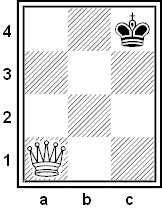
I’m not sure who originated this puzzle. Can the white queen force the black king onto square a1 of this 4 x 3 chessboard?

I’m not sure who originated this puzzle. Can the white queen force the black king onto square a1 of this 4 x 3 chessboard?
Conclusion of a letter from F. Scott Fitzgerald to his 12-year-old daughter Scottie, away at summer camp, Aug. 8, 1933:
Things to worry about:
Worry about courage
Worry about cleanliness
Worry about efficiency
Worry about horsemanship
Things not to worry about:
Don’t worry about popular opinion
Don’t worry about dolls
Don’t worry about the past
Don’t worry about the future
Don’t worry about growing up
Don’t worry about anybody getting ahead of you
Don’t worry about triumph
Don’t worry about failures unless it comes through your own fault
Don’t worry about mosquitoes
Don’t worry about flies
Don’t worry about insects in general
Don’t worry about parents
Don’t worry about boys
Don’t worry about disappointments
Don’t worry about pleasures
Don’t worry about satisfactions
Things to think about:
What am I really aiming at?
How good am I really in comparison to my contemporaries in regard to:
(a) Scholarship
(b) Do I really understand about people and am I able to get along with them?
(c) Am I trying to make my body a useful instrument or am I neglecting it?
“He didn’t want me to have the fun of making my own mistakes,” she wrote later. “He wanted to make them for me.”

Philadelphia’s Eastern State Penitentiary got an unusual inmate in 1924: “Pep the cat-murdering dog,” a black Labrador retriever who was allegedly incarcerated for killing the first lady’s favorite pet. In truth Pep was donated to the prison by governor Gifford Pinchot to improve morale; he was transferred to nearby Graterford Penitentiary in 1929.
Pep’s example was followed by Lady, a beagle who belonged to the captain of the prison’s guards. She posed for the second picture in 1957.
In American Notes, Dickens recalled that one inmate at Eastern State kept a rabbit in his cell; others kept birds and cats. And the prison was later home to Al Capone, who had some unusual quarters of his own.
Albert Herpin, born in France in 1862 and for fifteen years a hostler in the employ of Freeholder Walter Phares of this city, declares that he has not slept a wink during the past ten years. Notwithstanding this, he is in perfect health, and does not seem to suffer any discomfort from his remarkable condition. He goes to bed regularly, but says he never closes his eyes, or at least never for an instant loses consciousness of all going on about him. In the morning he arises refreshed and ready for another day’s work among the horses. He declares the change of position and the darkness of the room seem to give him all the rest he desires.
— “Hasn’t Slept in Ten Years,” New York Times, Feb. 29, 1904

Does the top of a rolling wheel move faster than the bottom? In his Cyclopedia of Puzzles (1914), Sam Loyd calls this “an old problem which has created a considerable discussion in the mechanical world.”
The rolling wheel retains its shape; it will arrive at its destination as a connected unit. This seems to imply that all of its parts are moving at the same speed. Yet the point in contact with the ground is moving not at all, while the top continuously overtakes it. Surely, then, the top is moving faster? “There is just enough of the mathematical and mechanical element in the make-up of the problem,” writes Loyd, “to provoke discussions from such as are well-up on these subjects.”
His answer: “The top of a wheel progresses exactly as fast as the bottom.” And, being Sam Loyd, he adds a wrinkle: “If the question referred to a mark on the tire the answer would be different, for the top is the highest point of the wheel and cannot revolve, for if it revolves the hundredth part of an inch it ceases to be the top.”
A second vexed wheel riddle; William James and Lewis Carroll consider related questions; a train moves simultaneously east and west.
In October 1955, shortly after winning the Pulitzer Prize, Marianne Moore was approached by the Ford Motor Company to help devise a name for a new series of cars. “We should like it to have a compelling quality in itself and by itself,” wrote marketing research manager David Wallace. “To convey, through association or other conjuration, some visceral feeling of elegance, fleetness, advanced features and design.”
Moore accepted the challenge and contributed her suggestions throughout the year that followed. These included:
Ford added these to its own growing list. Finally, in November 1956, Wallace sent her the company’s decision. “We have chosen a name out of the more than six-thousand-odd candidates that we gathered,” he wrote. “It has a certain ring to it. An air of gaiety and zest. At least, that’s what we keep saying. Our name, dear Miss Moore, is — Edsel.”

RICHARD MILHOUS NIXON and WILLIAM JEFFERSON CLINTON are the only U.S. presidents whose names contain the letters C-R-I-M-I-N-A-L.
Create two columns, one starting with the numbers 12 and 18 and the other with 5 and 5. Continue each column, deriving each new number by adding the two that precede it:

In the Journal of Recreational Mathematics, James Davis writes, “Forming successive pairs with adjoining numbers from each column one finds the ratio of the two numbers in each pair converges to π!” How can this be?
“The alert reader will suspect there is a trick in this method, as I did when π first presented it to me. The labor of several hours of computation coupled with trial and error produced half of the secret of the method. It is obviously based somehow on the fact that φ (the golden mean, which equals , can be closely approximated by the nifty pseudo equation below:”
“Can the reader decipher π’s technique for making herself with φ?”
There is a tradition to the effect that Noel Coward once sent identical notes to the twenty most prominent men in London, saying, ‘All is discovered. Escape while you can.’
All twenty abruptly left town.
— Paul C. Sherr, The Short Story and the Oral Tradition, 1970